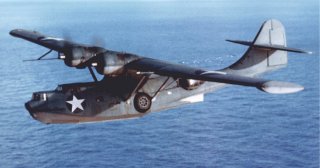Consolidated PBY: The Guardian Angels of the Atlantic During World War II
The Consolidated PBY seaplane was initially built to counter Japan in the Pacific. While it did serve in that theatre, it also provided invaluable escort duty to American convoys in the Atlantic.
The new World War II thriller Greyhound is an exciting film that portrays the Battle of the Atlantic from the perspective of a U.S. Navy destroyer Captain, played by Tom Hanks. In the film’s opening sequence, a seaplane can be seen providing air cover for a convoy bound for England. The plane provides the convoy some degree of protection against Nazi Germany’s U-Boat wolfpacks.
In the film, the odd looking plane signals to the convoy’s destroyer escort that it has reached its maximum range, and has to turn back to the East Coast. This distinctive-look plane was one of the guardian angels of the American convoys delivering supplies to Europe. Here’s why.
Consolidated PBY Catalina
Consolidated’s PBY design was prompted in part by Japan’s expansion into the Pacific during the 1930s. While The United States had until that point been one of, if not the dominant power in many parts of the Pacific Ocean, Japan’s increasingly powerful naval buildup began to worry Washington.
The PBY was designed to pull double duty as both a long-range bomber, and patrol and reconnaissance aircraft. It also had to have the internal capacity and lifting power to carry an adequate bomb load, as well as be able to ferry supplies around.
The admittedly ungainly-looking airplane had two 825 horsepower Pratt & Whitney radial engines mounted above and behind the cockpit into the wing’s leading edge. Thanks to the PBY’s intended use as a maritime patrol/bomber aircraft, it had a hull belly design, which allowed it to take off and land on water.
A pair of retractable floats were also mated to the wingtips. When landing, they swung outwards and prevented the wings from becoming buried in the sea, making the entire ocean the PBY’s runway. Consolidated also had the foresight to equip the PBY with retractable tricycle landing gear that allowed it to land on the ground as well. And, despite the awkward-looking appearance, the PBY had teeth.
Consolidated’s seaplane may have had one of the largest air crews of the pacific war—a whopping ten men rode or flew the plane. In addition to the pilot, co-pilot, radioman, engineer, and navigator, the PBY had a waist gunner in either side of the plane’s fuselage to man a .50 caliber gun inside two blister canopies, and another gunner who presumably was responsible for the two nose-mounted .30 caliber guns, and the single .30 caliber gun in the PBY’s tail. The seaplane also had mounts on the wings for free-falling bombs, depth charges, and could be equipped to carry torpedoes.
War’s End
Consolidated’s design was widely exported among the Allies during the war, and served with Canada, Great Britain, Australia, and the Soviet Union. Post-war, the sturdy seaboat enjoyed use in Latin America, particularly in service with Brazil and Chile. They were quickly retired from American service after the end of the War.
Caleb Larson is a defense writer with the National Interest. He holds a Master of Public Policy and covers U.S. and Russian security, European defense issues, and German politics and culture.

